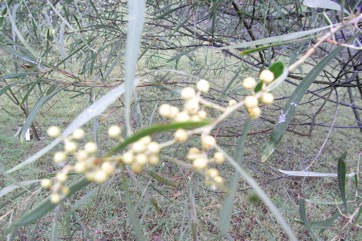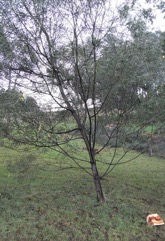Wirilda, Swamp Wattle

It is a warm temperate plant. It occurs naturally in the cooler parts of Australia. It grows on light to medium soils. It requires well drained soils and a sunny position although it can stand light shade. It is drought and frost resistant. It can grow in arid places. They grow where the minimum temperature is 3-5°C. In Tasmania they occur on Flinders Island. It can tolerate short periods of being in waterlogged soils. It can tolerate some salt. It suits hardiness zones 8-10. Arboretum Tasmania.
Also known as:
Keo son, Silver Wattle
Synonyms
- Acacia crassiuscula Wendl.
- Acacia provincialis A. Camus
- Acacia rostellifera sensu auct.
- Acacia floribunda sensu auct.
- Acacia longissima Chopinet
Edible Portion
- Seeds, Flowers, Pods, Gum
Where does Wirilda grow?
Found in: Africa, Asia, Australia, Azores, Britain, Caucasus, Colombia, Cyprus, East Africa, Easter Island, Ecuador, Egypt, Ethiopia, Europe, France, India, Indochina, Indonesia, Israel, Italy, Kenya, Mauritius, Mediterranean, Middle East, New Zealand, North Africa, Philippines, Portugal, Romania, Russia, SE Asia, South Africa, Southern Africa, South America, Spain, Tasmania, Vietnam, Yugoslavia, Zimbabwe
Notes: There are about 1,350 Acacia species. Over 1,000 occur in Australia. Also as Mimosaceae.
Growing Wirilda, Swamp Wattle
Cultivation: It is grown from seed. The seed need treatment to break the hard seed coat. Normally this is by putting the seeds in very hot water and letting the water cool down overnight then planting the seeds immediately.
Edible Uses: The pods are eaten. The seeds are eaten. They can be used to make flour for breads, cakes, pastries and desserts.
Production: It grows quickly. Flowers are produced November to January. Trees do not live a long time.
Nutrition Info
per 100g edible portion| Edible Part | Energy (kcal) | Protein (g) | Iron (mg) | Vitamin A (ug) | Vitamin c (mg) | Zinc (mg) | % Water |
|---|---|---|---|---|---|---|---|
| - | - | - | - | - | - |
Wirilda, Swamp Wattle Photos


References
Blamey, M and Grey-Wilson, C., 2005, Wild flowers of the Mediterranean. A & C Black London. p 79
Bodkin, F., 1991, Encyclopedia Botanica. Cornstalk publishing, p 31
Bonney, N., 1997, Economic Native Trees and Shrubs for South Australia. Greening Australia (SA) inc. Campbelltown SA 5074 p 18
Boomsma, C.D., 1972, Native Tree of South Australia. Woods & Forests Department South Australia, Bulletin No.19. p 43
Brickell, C. (Ed.), 1999, The Royal Horticultural Society A-Z Encyclopedia of Garden Plants. Convent Garden Books. p 61
Cherikoff V. & Isaacs, J., The Bush Food Handbook. How to gather, grow, process and cook Australian Wild Foods. Ti Tree Press, Australia p 47
Clarke,P. A., 2013, The Aboriginal Ethnobotany of the Adelaide Region, South Australia. Transactions of the Royal Society of South Australia. (2013), 137(1): 97-126
Cribb, A.B. & J.W., 1976, Wild Food in Australia, Fontana. p 103
Cundall, P., (ed.), 2004, Gardening Australia: flora: the gardener's bible. ABC Books. p 78
Curtis, W.M., 1956, The Students Flora of Tasmania Vol 1 p 124
Dashorst, G.R.M., and Jessop, J.P., 1998, Plants of the Adelaide Plains & Hills. Botanic Gardens of Adelaide and State Herbarium. p 78
Elliot, W.R., & Jones, D.L., 1982, Encyclopedia of Australian Plants suitable for cultivation. Vol 2. Lothian. p 106
Facciola, S., 1998, Cornucopia 2: a Source Book of Edible Plants. Kampong Publications, p 151 (As Acacia retinodes)
Hemphill, I, 2002, Spice Notes. Macmillan. p 413
Lazarides, M. & Hince, B., 1993, Handbook of Economic Plants of Australia, CSIRO. p 6
Linnaea 20:664. 1847
Lord, E.E., & Willis, J.H., 1999, Shrubs and Trees for Australian gardens. Lothian. p 41
Pham-Hoang Ho, 1999, An Illustrated Flora of Vietnam. Nha Xuat Ban Tre. p 821
Plants for a Future database, The Field, Penpol, Lostwithiel, Cornwall, PL22 0NG, UK. http://www.scs.leeds.ac.uk/pfaf/
Robins, J., 1996, Wild Lime. Cooking from the Bush food garden. Allen & Unwin p 166
Royal Botanic Gardens, Kew (1999). Survey of Economic Plants for Arid and Semi-Arid Lands (SEPASAL) database. Published on the Internet; http://www.rbgkew.org.uk/ceb/sepasal/internet [Accessed 27th April 2011]
Whiting, J. et al, 2004, Tasmania's Natural Flora. Tasmania's Natural Flora Editorial Committee PO Box 194, Ulverstone, Tasmania, Australia 7315 p 213
World Checklist of Useful Plant Species 2020. Royal Botanic Gardens, Kew
www.ceres.org/au/bushfood catalogue